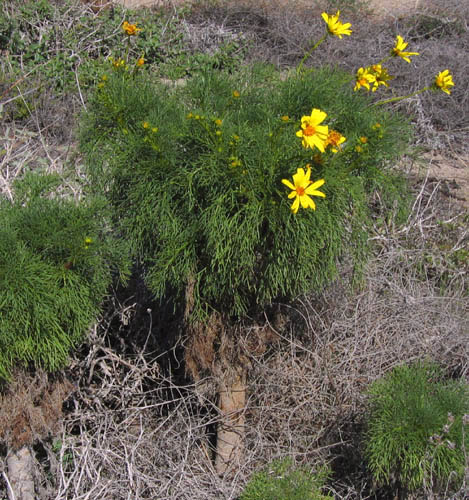
Giant coreopsis is a woody perennial and a member of the aster family, Asteraceae, that also includes sunflower, daisy, and lettuce. It is native to central and southern coastal California where it grows on dunes, chaparral hillsides, sage scrub, and sea bluffs. Plants grow up 3-4′ tall and have a succulent trunk up to 4″ thick with branches at the top that carry 1′ long tufts of bright green fern-like leaves . The leaves are bipinnate, up to 1′ long and are summer deciduous . They leaf out during the winter rains before going dormant after the plant blooms. The 2-3″ wide flower heads appear on long stems in the spring and consist of yellow ray flowers surrounding golden yellow disc flowers. Plants attract bees and are useful in wildflower gardens. Very drought tolerant, giant coreopsis is a good choice for a xeriscape and can be used as a hedge and for soil stabilization. The genus name, Coreopsis, comes from the Greek words koris meaning bug, and opsis meaning like/similar to and refers to the appearance of the seeds. The specific epithet, gigantea, comes from the Latin word gigans, meaning giant.
Type: Woody perennial
Bloom: Single, yellow, 2-3″ wide flower heads on long stems in spring
Size: 3-4′ H x 2-3′ W
Light:Full sun
Soil: Average, dry, very well-drained; very drought tolerant
Hardiness: Zones 10-11
Care: Cut off dead leaves in summer
Pests and Diseases: None of significance
Propagation: Cuttings in winter; seed
Companion Plants: Seacliff buckwheat, red sand verbena, beach sage, beach morningglory
Outstanding Selection: None available
Photo Credit: NPS Wikispeices